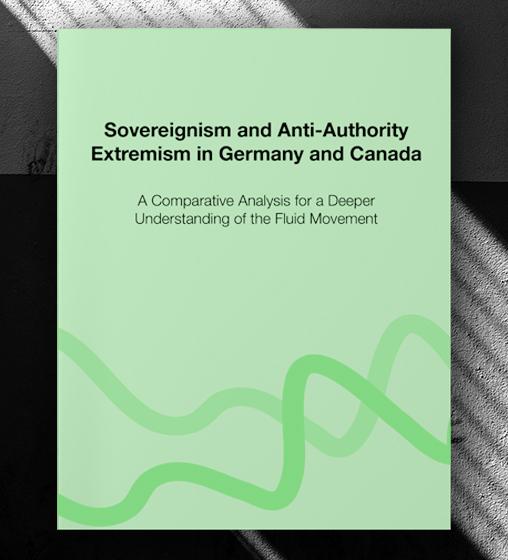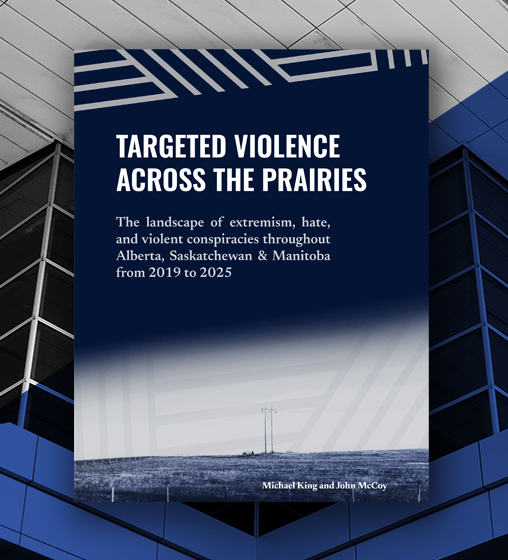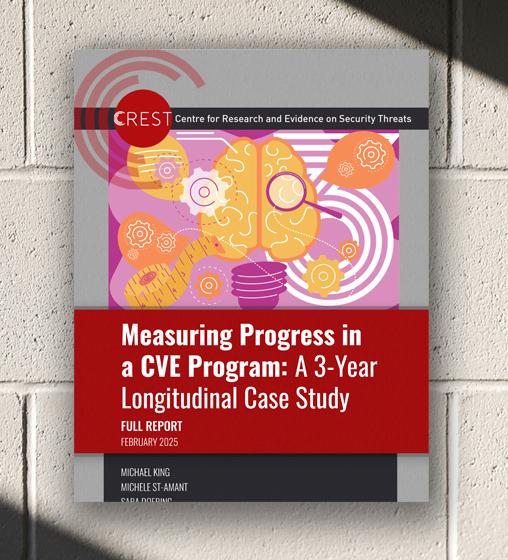For easier navigation, this report has been split up into sections. You’re currently reading the introduction. Use the buttons below to jump to the other sections of this report, or download the full pdf here.
Table of Contents
Introduction
Key Terms
Ideologically Motivated Violence Extremism (IMVE)
The Government of Canada defines ideologically motivated violent extremism (IMVE) as “a range of grievances and ideas from across the ideological spectrum”1. The definition is purposefully broad to incorporate various ideologies (i.e., gender and identity driven violence, xenophobia, and anti-authority extremism) in addition to a collection of more idiosyncratic and highly personalized grievances or conspiracies that can inspire an individual to mobilize to violence. Examples of IMVE groups or beliefs include: National Socialist Order / Atomwaffen Division, the Base, violent involuntary celibates, and organized militias.Religiously Motivated Violent Extremism (RMVE)
The Government of Canada defines religiously motivated violent extremism (RMVE) as a form of extremism which:“encourages violence as part of a spiritual struggle against perceived immorality. Adherents believe that salvation can only be achieved through violence.”2 Examples of RMVE groups or beliefs include: Al Qaeda, Daesh, the Aryan Nations and the Church of the Creator.Politically Motivated Violence Extremism (PMVE)
The Government of Canada defines politically motivated violent extremism (PMVE) as the collection of ideologies that legitimze violence to establish new political systems, or new structures and norms within existing systems.3 While the 20th century saw a significant amount of violence linked to PMVE groups, there has been a marked decline in activity over the last 20 years. Examples of PMVE groups include: the Provisional Irish Republica Army (PIRA), the Front de libération du Québec (FLQ), and the Fuerzas Armadas Revolucionarias de Colombia—Ejército del Pueblo (FARC).Hate Crimes
Hate-motivated offences, or hate crimes, are recognized in several different ways in the Criminal Code. First, there are three speech related offences found under the Hate Propaganda section of the Criminal Code: 318 (1) – Advocating Genocide, 319 (1) – Public Incitement of Hatred, and 319 (2) – Willful Promotion of Hatred. There are two additional ways in which criminal offences motivated by hate are recognized: either via a mischief charge where the target of the offence is a religious or educational institution (Section 430 (4.3) of the Criminal Code) or through consideration of a possible hate motivation as an aggravating factor considered during sentencing, as provided for by Section 718 (2) of the Criminal Code.Hate Incidents
A non-criminal offence committed against a person or property that is motivated by an individual’s hatred or bias towards an identifiable group. While non-criminal, these incidents can have a profound impact on victims and the broader community. These incidents may include online abuse, verbal taunting, or slurs.Extremism
Extremism refers to the use of “religious, social, or political belief systems that exist substantially outside of belief systems more broadly accepted in society (I.e., “mainstream” beliefs).”4 While extremist beliefs in-and-of themselves do not necessarily prescribe violence, they do seek radical changes and exist outside mainstream societal beliefs.Violent Extremism
Violent extremism is a term that refers to a subset of extremist ideologies that legitimize the use of violence; and the use of violence is usually a core tenet within these specific extremist ideologies.Disclaimer
The information and findings in the document have been printed on the basis of publicly available information and research. It should not be interpreted to represent the opinions of the individuals or agencies who participated in interviews with the Organization for the Prevention of Violence.
Executive Summary
There have been significant changes in the three years since the Organization for the Prevention of Violence (OPV) published its first report about hate-motivated violence, extremism and terrorism in Alberta, Building Awareness, Seeking Solutions. The Covid-19 pandemic, protests against public health measures, tense elections in the United States, and the backlash to racial justice movements, among other events, have had broad social repercussions. Some of which have changed the composition and scale of the threat of extremism and terrorism – which has become more diffuse and comprised of a broader set of grievances and ideologies.
This report is organized using the nomenclature developed by the Government of Canada to categorize different forms of extremist ideologies. As such, the findings related to ideologically motivated violent extremism and religiously motivated violent extremism are summarized first.i Next, we summarize our findings about conspiracy theories and hate incidents, including crimes, within Alberta and across Canada.
i – Although the Government of Canada includes Politically-Motivated Violent Extremism as a category, this report does not include a section on this form of extremism. While this form of extremism exists elsewhere in the world and has existed historically in Canada, it has not occurred in Canada within the specified time-frame of this report.
Ideologically Motivated Violent Extremism (IMVE)
- The structure and landscape of IMVE actors continues its shift from group-based tactics to lone-actor and small-cell activity, particularly within the realm of xenophobic extremism. A new emphasis on militant accelerationism coupled with eschewing organized activities to avoid detection makes these attackers less predictable.5
- After years of stagnation, or in some cases a decline in activity in Canada, the anti-authority movement has experienced a reinvigoration, partly as a reaction to public health measures enacted during the Covid-19 pandemic and the spread of misinformation and conspiracy theories.
- Extremists are increasingly picking and choosing elements of different violent ideologies to form their own idiosyncratic belief system. This “salad bar’ extremism, originally used to describe an emerging phenomenon in the U.S., is now present in Canada.6
- The Covid-19 pandemic and the 2020 U.S. Presidential election, among other events, has led to a re-energized pseudo-legal movement, which shares some common elements with the anti-authority movement and has become particularly active in North America, parts of Europe, and Australia. While the overwhelming majority of individuals within the pseudo-legal movement are non-violent, the surge in popularity and spread of ideas has the potential to incite individuals to mobilize to violence, particularly against public or authority figures.
- Militia and patriot groups have been in decline in Canada, particularly in Alberta. Groups such as the Soldiers of Odin and the Three Percenters have now largely dissolved or splintered.
Religiously Motivated Violent Extremism (RMVE)
- RMVE has continued its steady decline in Canada since the publication of the OPV’s last report. With the significant territorial losses experienced by Daesh in Syria and Iraq over the last several years, there have been far fewer instances of Westerners traveling to join Daesh, as well as fewer attacks in Western countries inspired by Daesh.
- Attention has now turned to Canadian foreign fighters and their familes, many of whom are currently held in detention camps and prisons in Syria. Of these, the Canadian government has repatriated one orphan, while the return of a women from Alberta and her child was facilitated by a former U.S. diplomat.
- Although RMVE activity has declined, the threat remains, as shown by the 2019 arrest of a youth in Kingston with explosives, and a fatal hammer assault in Toronto in 2020.
- Networks of radicalizing influencers and facilitators of terrorist activity continue to operate in Canada, with the potential to play a role in future foreign fighter mobilization or domestic attacks.
Conspiracy Theories
- While conspiracies have always been a cornerstone of extremism and hate-motivated ideologies, these have proliferated in recent years. Some individuals are now mobilizing around a set of conspiracies, such as QAnon, Covid-19 or 5G linked conspiracies unrelated to traditional extremist ideologies, but increasingly incorporated and utilized by anti-authority and xenophobic extremists.
- Several QAnon influencers have emerged across Canada since the OPV’s last report. These include Romana Didulo, who has proclaimed herself Queen of Canada, “Amazing Polly,” who is credited with starting the infamous Wayfair conspiracy of 2020, and Alexis Trudel-Cossette, a Quebec-based QAnon influencer who has become prolific across theFrench-speaking conspiracy world.
Hate Incidents and Crimes
- Canada has seen a steady increase in the number of hate crimes since the publication of the OPV’s last report. Underreporting continues to be a problem in understanding the number and prevalence of hate crimes across the country.
- Reporting of hate crimes committed against the Asian community since the onset of the Covid-19 pandemic have risen.
- Racial justice protests, which have gained traction since 2020, have attracted counter-protests by hate-motivated groups across Alberta and Canada.
- Edmonton has seen a unique trend of hate-motivated attacks against Black Muslim women. Between 2020 and the publication of this report, seven Black Muslim women were targeted, threatened, or attacked in Alberta’s capital.
Introduction
According to a recent poll, many Canadians have expressed concerns about the rise of hate and extremism, and in particular the rise of right-wing extremism and terrorism.7 This concern is well founded. In the last 10 years, Canada has experienced a significant rise in the ranks of the Institute for Economics and Peace’s Global Terrorism Index, a comprehensive study analyzing the amount and severity of terrorism across 163 countries.8
Canada ranked 90th globally in 2011. It increased to 67th in 2016 and further to 48th in 2021. This development is in part a result of several recent tragic attacks like the London, Ontario truck attack in 2021, which resulted in the deaths of four members of a Canadian-Pakistani family; and earlier events linked to lone actor terrorism, such as the Toronto van attack in 2018 and Quebec City Mosque attack of 2017.
In the last several years, and especially since the Organization for the Prevention of Violence (OPV) published its first report about Alberta in 2019, Building Awareness, Seeking Solutions, the landscape of hate-motivated violence, extremism, and terrorism has changed in Alberta, as it did across Canada. Some extremist and hate-motivated groups and ideologies – many of which are unique to Canada – have seen a surge in recent years, including xenophobic and anti-authority movements.
Using the Government of Canada’s nomenclature, these forms of hate-motivated violence are classified under ideologically motivated violent extremism (IMVE). Others, including religiously motivated violent extremist (RMVE) groups, have continued to experience a marked decline in Canada and Alberta. This is largely due to territorial losses Daesh experienced in Syria and Iraq, despite maintaining a strong presence or gaining a foothold in other countries.
Concurrently, Canada has seen a steady increase in the number of hate crimes. Between 2016 and 2020, Statistics Canada reported an 89% increase in the number of police-reported hate crimes across the country.9 Reflecting those who were victimized in attacks in London and Quebec City in recent years, rising hate-motivated incidents have disproportionately impacted religious minority communities and people of colour, a trend which has also presented itself outside of Canada, such as in the United States.
These rising indicators point to pressures on Canada’s social cohesion, and a persistent threat to public safety. Additionally, the increasingly online and transnational nature of extremism, terrorism, and hate activity means that Canada is not immune to these problems.
Consistent with the mission of the organization, our goal is to share evidence-based knowledge that can inform prevention efforts and to this end, the OPV has conducted in-depth research in Alberta. To date, for our previous and current reports, the OPV has interviewed nearly 200 members of the RCMP, municipal police agencies and community stakeholders across the province, including the province’s urban and rural areas, northernmost, and southernmost regions.
In addition to these interviews with Alberta law enforcement, this report outlines the domestic historical foundations and the transnational roots of hate-motivated violence, extremism, and terrorism, which we hope will help the reader better understand the current trends and threats.
As such, this report provides a historically-grounded and contextual approach for readers who wish to understand the ways in which current forms of hate-motivated violence and extremism are inspired and influenced by the past.
It is our hope that the research presented in this report will help Albertans better understand, identify, and find solutions to the threats and challenges present in their communities.
Endnotes
- Canadian Security Intelligence Service, CSIS Public Report 2019 (April 2020), p. 13, https://www.canada.ca/content/dam/csis-scrs/documents/publications/PubRep-2019-E.pdf.
- Canadian Security Intelligence Service, CSIS Public Report 2021 (March 2022), p. 25, https://www.canada.ca/content/dam/csis-scrs/documents/publications/2021/public-report/2021_PublicReport_Digital-ENG.pdf.
- Canadian Security Intelligence Service, CSIS Public Report 2021 (March 2022), https://www.canada.ca/content/dam/csis-scrs/documents/publications/2021/public-report/2021_PublicReport_Digital-ENG.pdf.
- Anti-Defamation League Staff, ”Extremism,” Anti-Defamation League, May 3, 2017, https://www.adl.org/resources/glossary-terms/extremism.
- Seth G. Jones, Catrina Doxsee, and Nicholas Harrington, The Escalating Terrorism Problem in the United States (Washington, DC: Center for Strategic & International Studies, June 17, 2020), https://www.csis.org/analysis/escalating-terrorism-problem-united-states.
The Soufan Center, “IntelBrief: The Counterterrorism Challenge of ‘Salad Bar’ Ideologies,” March 29, 2021, https://thesoufancenter.org/intelbrief-2021-march-29/.
Angelyn Francis, “Most Canadians are fed up with online hatred and discrimination and want to see Parliament act, new survey says,” Toronto Star, November 30, 2021, https://www.thestar.com/news/canada/2021/11/30/most-canadians-are-fed-up-with-online-hatred-and-discrimination-and-want-to-see-parliament-act-new-survey-says.html.
- Visions of Humanity, “Global Terrorism Index 2021,” 2021, https://www.visionofhumanity.org/maps/global-terrorism-index/#/.
- Statistics Canada, “Police-reported hate crimes, number of incidents and rate per 100,000 population, Census Metropolitan Areas,” https://www150.statcan.gc.ca/t1/tbl1/en/tv.action?pid=3510019101.



